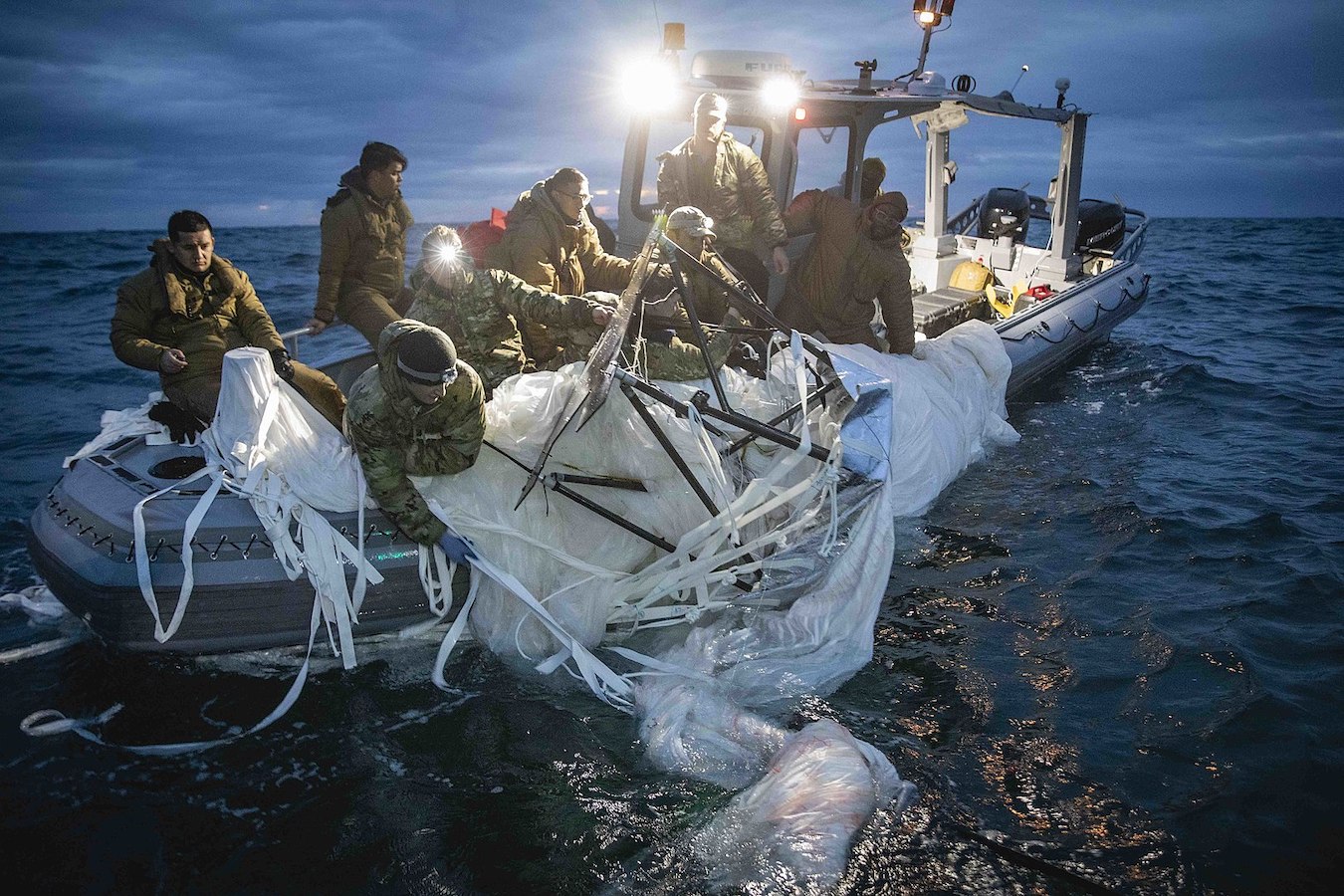by Brian Hioe
語言:
English
Photo Credit: Russotp/WikiCommons/CC BY-SA 4.0
CONTROVERSY–AS WELL as mockery–has broken out after a purported Chinese spy balloon was detected over the US and then later shot down over the Atlantic Ocean last week.
The balloon was originally spotted over the West Coast of the US and then drifted to the East Coast over the course of a week. Some speculation is that the balloon should have crossed the US in two days, but that its progress was slower due to global warming. The balloon was detected near nuclear weapons facilities operated by the US and other bases.
The balloon reportedly had a payload of equipment that hung underneath it, estimated to be around the size of two or three school buses, and had limited steering ability using a rudder. As a result, the US government initially declined to shoot it down, given the possibility of wreckage from the balloon impacting civilian populations or the possibility of provoking China.
 Size comparison of the balloon. Photo credit: osunpokeh/WikiCommons/CC BY-SA 4.0
Size comparison of the balloon. Photo credit: osunpokeh/WikiCommons/CC BY-SA 4.0
As time went on, however, there were increasing calls for US President Joe Biden to take action in shooting down the balloon. US politicians framed Biden’s initial reluctance to shoot down the balloon as a sign of weakness. The balloon was thus shot down by an F-22 with an AIM-9 Sidewinder. The US later undertook a search for the wreckage from the balloon.
For its part, the Chinese government claimed that the balloon was a weather balloon that had been blown off course, stating that it regretted the incident. In comments to the media, US officials initially indicated that China’s response suggested confusion. But later it was reported that a similar suspected Chinese spy balloon had been detected near Latin America with China eventually claiming ownership of the balloon, just denying that the balloon was for anything apart from civilian purposes
Regardless of the nature of the balloon, it is unclear why China deployed it at such a sensitive juncture–shortly before a scheduled diplomatic visit to Beijing by US Secretary of State Antony Blinken. Raising further questions is that at the time why the Biden administration declined to shoot down the balloon, US officials first indicated that the balloon had limited capacity to gather intelligence compared to satellite imagery, and so downplayed the dangers that came from taking limited action over it.
The Blinken trip has now been postponed–perhaps indefinitely–in the wake of fallout over the incident. China has condemned the US’s actions in shooting down what it frames as an unmanned civilian aircraft and stated that it could take reciprocal action over similar actions by the US in the future. Moreover, after criticisms from former US president Donald Trump, the Biden administration now asserts that there was, in fact, a series of such balloon spying incidents in the past–just that these had not previously been linked to China. Similar balloons have been reported around Japan and India in the past, as well.
As a result, then, the overall effect of the incident has been a ramping up of tensions between the US and China. That being said, many–particularly on the left–have not taken the incident seriously because of the apparently comical nature of the balloon and its shooting down.
With regards to the balloon, it is probably best to take the statements of neither the US or China at face value. But looking at the incident only in a humorous light is probably to make light of what could have been a serious incident. For example, while the Biden administration was eventually pushed to shoot down the balloon to avoid appearing weak, one notes how much more hyperbolic rhetoric from hawkish Republicans would have been if wreckage from the balloon had indeed affected civilian populations and led to casualties.
Or, vice-versa, if the balloon had instead been some form of manned aircraft, but hawkish Republicans had called for it to be shot down, and then shooting down the balloon had led to Chinese casualties. This, too, would have also stoked calls by Chinese nationalists for retaliation against the US.
 US sailors recovering debris from the balloon. US Navy/Public Domain
US sailors recovering debris from the balloon. US Navy/Public Domain
In the aftermath of the incident, tankies have sought to frame this as simply being another act of US aggression. Afterward, for example, one saw a map circulating online of purported US bases around China to suggest that China’s actions were in fact provoked by the US–never mind that this clearly inaccurate map somehow shows the US as having a military base located in Hong Kong.
In the meantime in Taiwan, the Taiwanese government has stated that it detected similar balloons in the past, but that this was not a matter of concern. Namely, such balloons were to gather meteorological data for the People’s Liberation Army’s Eastern Theater Command.
Although Taiwan often sees incursions into its Air Defense Identification Zone by Chinese warplanes, Taiwan does not respond by shooting down such warplanes. But it is improbable that Taiwan would not shoot down an unmanned aircraft, with DPP legislative caucus secretary-general Cheng Yun-peng stating that Taiwan should do this in the event of a similar incident with a Chinese balloon. That being said, the Taiwanese government will also hope to avoid mockery of perceived ineptitude, with previous videos of Taiwanese soldiers throwing rocks at a drone having previously attracted ridicule.

